Misc
[INTERVIEW] Roger Conners Talks the Making of ‘MEAT’: Killer Costumes, Queer Panic, and Carnage in Cleveland

Horror Press is always on the prowl for great indie horror films, and there are few films we’ve been following the development of as closely as MEAT.
An Interview With MEAT Director Roger Conners
When a self-destructive friend circle lets one of their own take the fall after a night of drug-filled partying goes wrong, their biggest mistake comes back to haunt them years later. With their old friend out of jail, a killer named The Stud is on the loose to exact vengeance for the events of that night, picking off members of the group one by one. And as the poster and trailer promise, this time, he’s going in raw.
The film has made quite the buzz in the horror community and is wrapping up the final stretch of its long funding campaign on IndieGogo and Kickstarter. But who is Roger Conners, the director and co-writer behind MEAT? What drove him to make the film, and how did the villainous design of Stud come to be? We find out about that, and a whole lot more, in an exclusive interview, one you can only find here on Horror Press.
***
So, just want to start off by saying I really am glad you could talk to us here at Horror Press about MEAT. It’s one of the projects we’ve been keeping our eyes on, and I know a good chunk of our readers have been too.
Roger Conners: I very much appreciate hearing that! My team and I are so thankful for the overwhelming amount of support we have received for MEAT.

A lot of people ask for an elevator pitch of a film, but I want to put the heat on you here. In ten words or less, tell me what MEAT is about. Condense the spirit of the film down for me.
RC: Mean gays do shitty things and get their deserved comeuppance.
MEAT is an unabashedly queer film. It’s an LGBTQ+ themed slasher as you’ve put it. Could you tell us what the intersection between the creation of the film and the queer community has been like throughout making it?
RC: I’ve been working in indie film since I was 19 years old, and when I started this journey things were very different, especially when it came to queer representation in cinema, horror or otherwise. Queer characters were rare to come by, and if they did exist, they were often presented as an over-the-top stereotype or as some form of comedic relief. Today, queer characters have the potential to be much more layered and nuanced. This is why I feel MEAT succeeds. Yes, it’s a slasher. Yes, it’s jam-packed with gut-churning gore that horror fans will love. But I assure you that it is also so much more.

MEAT was shot in Ohio, your home state. Given the inherently political nature of the film, and the conversations going on in Ohio regarding the suppression of queer and trans rights, were there any reservations towards making MEAT there? Did it fuel your artistic process?
RC: While Ohio is an extremely conservative state that is brimming with anti-abortion billboards and anti-queer rhetoric, Cleveland is very much a little blue dot surrounded by a sea of red. We do often see much of that hostility and aggression overflowing into our neighborhoods and infesting our safe spaces. A local community theatre I support has been dealing with picketers who bombard their local drag queen story-time, and seeing that in my backyard has certainly been a harsh smack of reality. These moments fuel my fire and make me feel that MEAT is more important than ever. There are still voices out there attempting to drown us out, so we need to rise above the noise and ensure that we remain outspoken, vigilant, and constantly aware. Crafting cinema that focuses on the LGBTQIA+ community is my way of speaking out.
What was the first queer horror film you ever saw, and do you think there are any echoes of it in MEAT?
RC: I remember seeing Hellbent in the mid-2000s, which really blew my mind. It was so unlike anything else I had seen up to this point. I absolutely channeled my love for that film while crafting a queer-themed slasher of my own. It inspired me to think outside the box and consider the idea that queer characters could not only exist within a horror film, but could also lead one.
One of the bigger challenges of indie filmmaking is that there are inevitably ideas that need to be left on the cutting room floor, primarily because of cost. Were there any ideas you were able to make work that you didn’t initially think would happen?
RC: I always tend to write big and then scale it back until it becomes achievable within our means. The original treatment for MEAT was about 150+ pages long and brimming with over-the-top sequences that would be difficult to pull off on an independent budget. Luckily, my co-writer Zach Shildwachter is far more reasonable than I am and was able to reel me back a bit. But overall, the script has remained true to the original concept, and most of the standout moments of gore that I originally envisioned made it to the final draft.
You’re in Phase 3 of MEAT’s funding campaign, with (at the time of writing this) just under a month left on IndieGogo. Could you detail the most challenging part of finishing MEAT on the production side of things?
RC: We have had varying levels of success with our three attempts at crowdfunding through Indiegogo, and thankfully Phase 3 has proven to be our most successful by far. While we certainly saw support early on in our process, we didn’t have much to show for it because we were just starting off and getting the ball rolling. There was no footage so no trailers, no stills, and not much to help convince fans of the genre that this was a project worth backing. I ended up funding most of what we filmed over the first year out of my pocket. While it was extremely stressful and financially draining, it was worth it. We decided to film the movie in three chunks, and we then used our early footage to create a teaser trailer to help promote our content. That really helped stimulate a significant amount of attention for our film.

Having one of the more memorable slasher villain designs in recent memory, The Stud, I was wondering if there were any particular inspirations for the killer we might not immediately assume?
RC: You know, the idea of the aesthetic of the killer’s costume really started with that jacket. I had it custom-made for myself and used it for a photo shoot, and every time someone saw it, the first thing that came out of their mouth was, “You could kill somebody with that thing!” And the fact is, yes, you could. It weighs about 50 lbs., and those spikes are all very much real, it would get such a response from people I knew it was just worth utilizing it. So, I designed a few prototypes built around the jacket, and we decided to lean into the whole fetish/bondage/leather vibe with the harness and the rubber suit.
Can the actor actually see out of that thing or does The Stud need a handler?
RC: The mask is as difficult to see through as you think it is, so we must strategically choreograph every sequence involving the killer. Every step, every turn, every grab must be perfectly timed to ensure that the actor under the mask is always safe and able to confidently operate within his surroundings. It provides a lot of challenges, but I think it’s absolutely worth the hassle.

And in terms of The Stud ripping and tearing through his victims, how nasty can the fans out there expect MEAT to get?
RC: Oh, let me assure you that the violence and gore are absolutely of the utmost importance here. Sure, this is a piece of queer cinema that’s telling a queer story, but first and foremost this is a queer slasher, and it’s intended to give fans of the genre exactly what they want from it. The kills are our top priority, and we are going all in on the practical effects and intensity of the kills. A great example in my mind would be the climax of Karyn Kusama’s The Invitation. Those whole final 15 minutes or so take your breath away, and it just felt so real and visceral and unflinching. That’s the kind of tone I’m striving for here. Brutal, unsympathetic horror with a high body count.
The concept trailer for MEAT has a very catchy song by synth artist Toska Bear behind it. Working with Toska Bear and finding MEAT’s musical voice, placing it at the forefront for selling your movie, how did that process happen?
RC: I’ve known Jason, aka Toska Bear for years now, and I’ve been following his journey and the progression of his sound, which is honestly so kickass, and I jam to it regularly, so I knew I wanted to incorporate a few of his tracks in MEAT. One day I kind of just fell into a black hole of listening to Prom Queen Days on loop, and I started envisioning how it could play into the movie, so I just asked him on a whim, and he was super into the idea right off the bat. I started using his music as a soundtrack for the conceptual stages of pre-production while we were creating the look for The Stud and style of the film and the overall vibe we were going for. It was hugely influential on the tone of the movie, so I’m very thankful he’s been so generous with allowing us to use his music throughout it.
You have been an assistant director on many projects, but also primarily an actor from what I understand. Does that give you a sort of edge as a director when it comes to directing your cast?
RC: I feel that the connection I share with my cast is probably my strongest suit as a director. Having been an actor for the majority of my life, I know what I personally expect from a director and what I need to help build upon my performance in order to truly deliver. I like to think I provide my cast with a safe space where they’re encouraged to dive a little deeper and really explore the depths of their characters’ psyche, and I definitely motivate them to go there.

You’ve mentioned on your Horror Press Podcast appearance that very few filmmakers are out here making queer horror films, and it’s true. Do you have any contemporaries you would want to give a shout-out to, or personal inspirations that deserve mention?
RC: I know you interviewed them recently, but the Monster Makeup boys out of Rhode Island are kickass. Their most recent title, Saint Drogo exceeded my expectations in so many ways. I mean, it left my jaw on the floor and had me thinking about it for weeks after my initial viewing. Then, of course, we have my beloved podcast co-host Troy Escamilla, whom I was lucky enough to work with on the set for Teacher Shortage, and we’re going to be reuniting for his next feature, Hollow Lake, in the summer of 2024. I’ve recently had the chance to watch works from Chris Moore and Jay Pmlieri, and they are both fantastic artists with defined styles that I really enjoy.
We all watch the classics, your Halloween’s, Nightmare’s and Friday’s. But what are some obscure slasher movies you think most people don’t know about that they should? What’s a lesser-known must-watch for you?
RC: Some of my favorite slashers would be titles such as Stage Fright, Intruder, and The Prowler, which offer up some of the finest kills from within the genre.
Daydream with me a bit. No reins, no questions asked, just unlimited funding, whatever you need to make it. What kind of horror movie would you make? Would it be a sequel to Meat, or something more out there?
RC: Oh, you mean MEAT: 2 the Bone? Oh yes, that’s definitely something I envision coming to fruition at some point in the near future. I have a script for a pretty wild body-horror-infused outbreak film like The Crazies, Demons, or even The Sadness. The only thing scarier than one person trying to hunt you down is 50 people trying to hunt you down. A film like that falls right in my wheelhouse, but one step at a time. Before I talk about anything else, I need to ensure I serve up a delicious serving of MEAT to our very patient and supportive fanbase. They deserve something meaty to sink their teeth into.
***
And there you have it, my carnivorous film fans; you get to see how the sausage gets made. To support Roger and the rest of the MEAT cast and crew, check out the IndieGogo to contribute to the film here! Make sure to also follow Roger on Twitter here, and Zach on Twitter here for the latest updates on MEAT.
And for more articles and interviews like this one on the latest and greatest in horror movies, television, and news, stay tuned to Horror Press!

Misc
Our Halloween Giveaway Is Here!
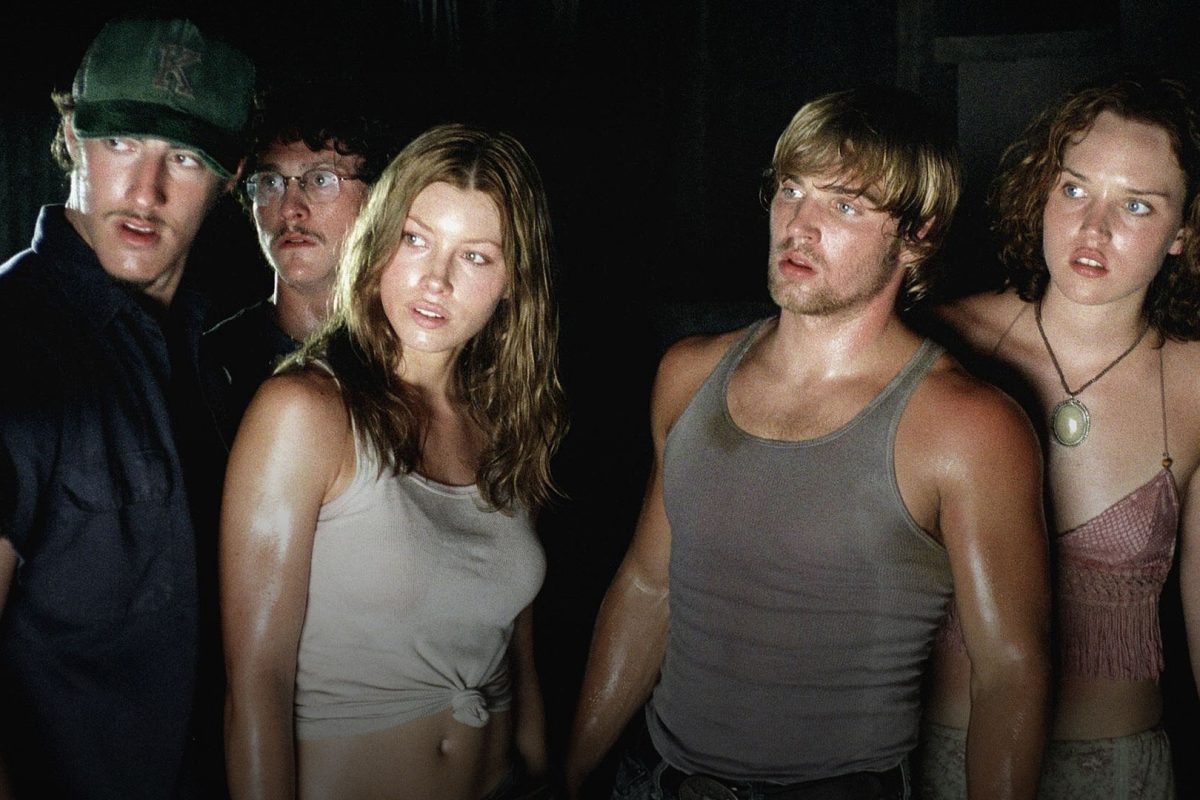
Enter Our Halloween Giveaway!
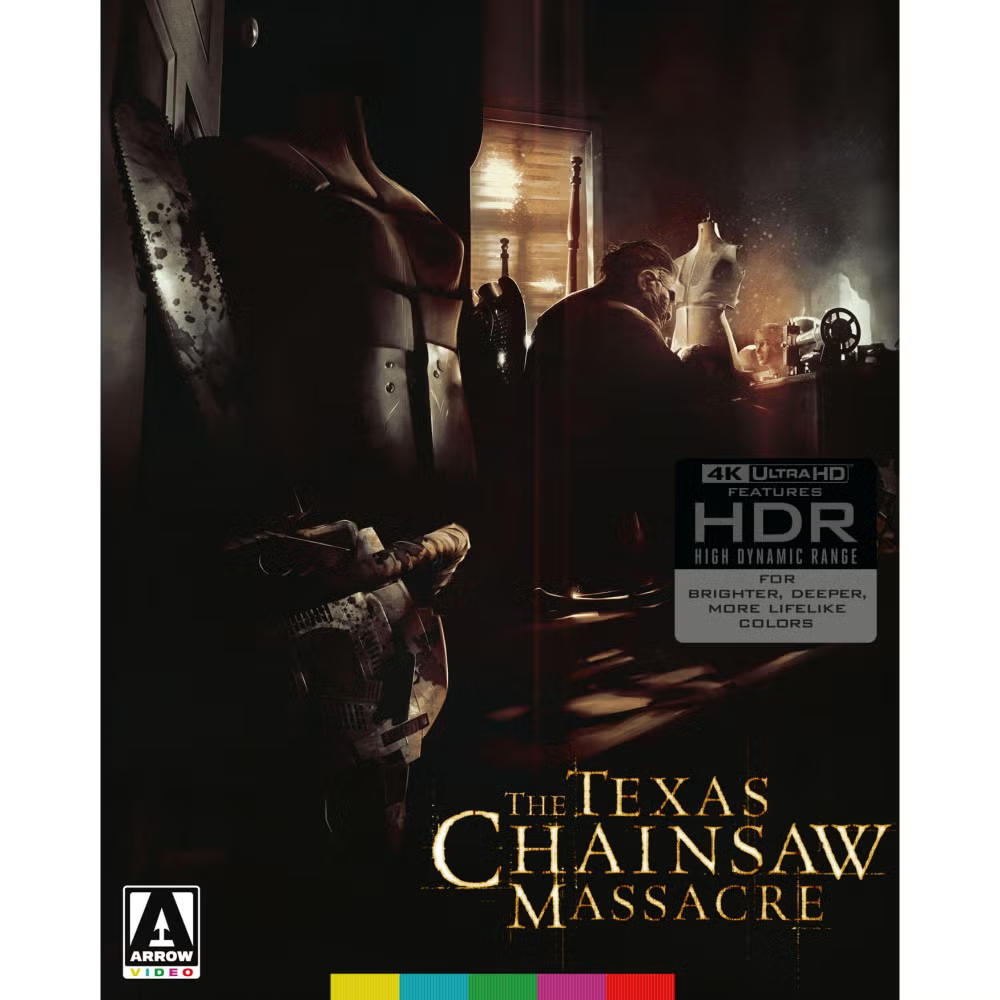
How to Enter:
Step 1. Make sure to FOLLOW US ON FACEBOOK AND JOIN OUR FACEBOOK GROUP!
Step 2. LIKE AND SHARE the giveaway post!
Step 3. This is the most important step, email us at contact@horrorpress.com with your FULL Facebook name (so we can verify you’re in the group) and who your favorite character is from the Texas Chainsaw franchise.
**Giveaway entries are limited to addresses in the United States.**
**All entries must be 18 or older to enter**
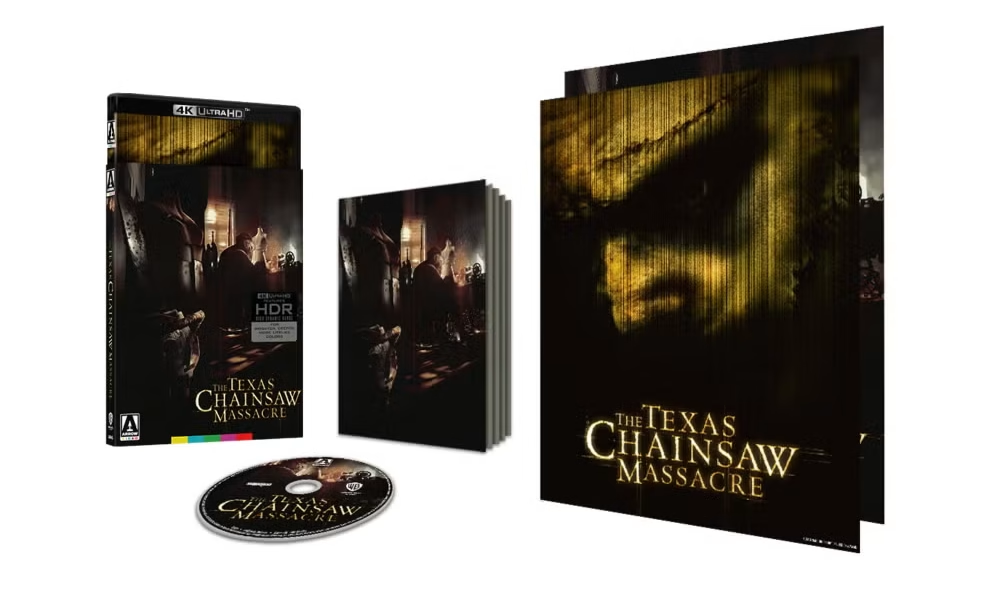
What You’ll Win
The Texas Chainsaw Massacre (2003) Limited Edition 4K UHD from Arrow Video
- 4K (2160p) Ultra HD Blu-ray presentation in Dolby Vision (HDR10 compatible)
- Original DTS-HD MA 7.1 and 5.1 surround audio and lossless stereo audio
- Optional English subtitles for the deaf and hard of hearing
- Brand new audio commentary with Dread Central co-founder Steve “Uncle Creepy” Barton and co-host of The Spooky Picture Show podcast Chris MacGibbon
- Archival audio commentary with director Marcus Nispel, producer Michael Bay, executive producers Brad Fuller and Andrew Form and New Line Cinema founder Robert Shaye
- Archival audio commentary with Marcus Nispel, director of photography Daniel Pearl, production designer Greg Blair, art director Scott Gallager, sound supervisor Trevor Jolly and composer Steve Jablonsky
- Archival audio commentary with Marcus Nispel, Michael Bay, writer Scott Kosar, Brad Fuller, Andrew Form and actors Jessica Biel, Erica Leerhsen, Eric Balfour Jonathan Tucker, Mike Vogel and Andrew Bryniarski
- Reimagining a Classic, a brand new interview with director Marcus Nispel
- Shadows of Yesteryear, a brand new interview with cinematographer Daniel Pearl
- The Lost Leatherface, a brand new interview with actor Brett Wagner
- Masks and Massacres, a brand new interview with makeup effects artist Scott Stoddard
- Chainsaw Symphony, a brand new interview with composer Steve Jablonsky
- Chainsaw Redux: Making A Massacre, a making-of documentary
- Ed Gein: The Ghoul of Plainfield, an in-depth look at the infamous killer who inspired the character of Leatherface
- Severed Parts, a look at the cutting room floor and some of the scenes excised from the final edit
- Deleted scenes including an alternate opening and ending
- Screen tests for Jessica Biel, Eric Balfour and Erica Leerhsen
- Behind-the-scenes featurette
- Cast and crew interviews
- Theatrical trailers and TV spots
- Concept art galleries
- Reversible sleeve featuring original and newly commissioned artwork by Aaron Lea
- Double-sided foldout poster featuring original and newly commissioned artwork by Aaron Lea
- Illustrated collector’s booklet featuring new writing on the film by Michael Gingold
Misc
NYCC 2025 Horror Highlights: A Sneak Peek at ‘The Lost Boys’ Musical, ‘Resident Evil: Requiem,’ and More!
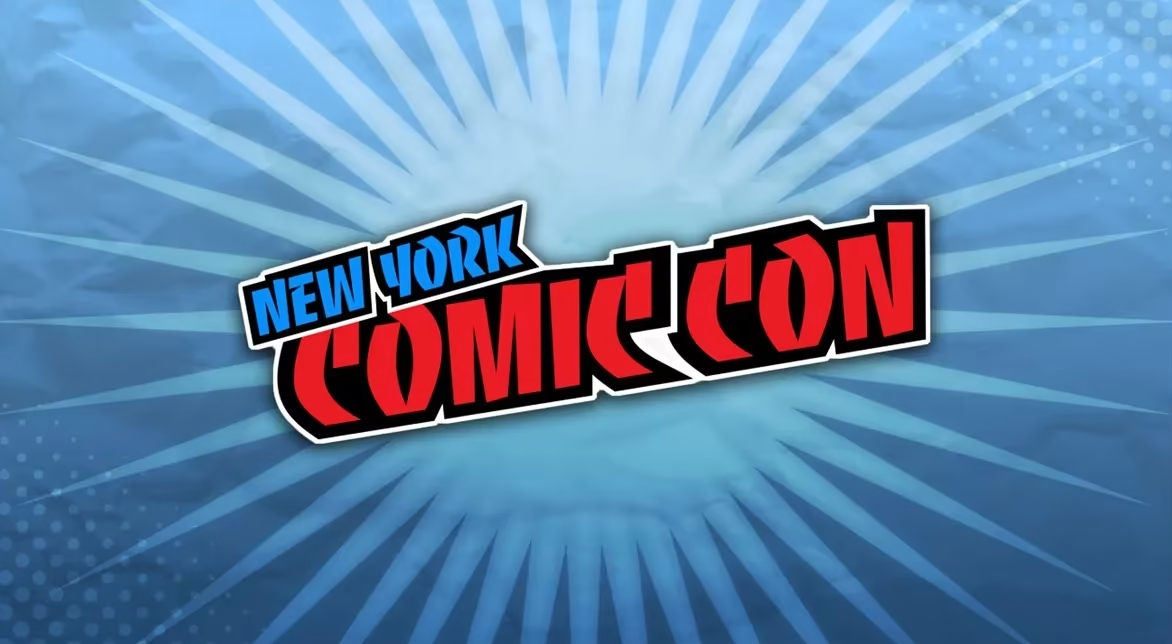
As soon as New York Comic Con announced that its 2025 theme would be “haunted,” I started lacing up my comfy shoes and making a beeline for the Javitz Center! Horror has always been represented at the con, but it felt fitting that it should play a central role in this year’s event at a time when the genre seems more popular than ever.
From beloved family-friendly properties like The Nightmare Before Christmas to pants-dampening titles like the upcoming Resident Evil: Requiem, horror appeared in countless shapes and forms. Here are all the best and scariest insights I gleaned from the show floor, panel rooms, and pop-ups of New York Comic Con 2025!
Our NYCC 2025 Horror Highlights
Resident Evil: Requiem Is Going to Test Your Bladder Strength
Full disclaimer: I’m not a gamer. I’m honestly pretty bad at games, which made my Resident Evil: Requiem play session all the more frightening because I was convinced that everyone around me would realize I’m a fraud. But with easy-to-grasp controls, even for a newb like me, the latest installment in the iconic horror franchise quickly sucked me in and left me on edge for entirely different reasons.
During my 30-minute session, I was introduced to FBI analyst Grace Ashcroft, Requiem’s central character. She swims to consciousness to find herself strapped upside down on a gurney with a needle in her arm, siphoning her blood. After Grace managed to free herself, the controls were handed over to me to explore the creepy facility through Grace’s eyes, looking for a fuse. Some spaces were bathed in red light; others were lit only by flickering bulbs that left me white-knuckling the controller, waiting for something to emerge from the shadows and swallow me whole, not helped by Grace’s anxious, stuttering breathing in my ear.
I took a moment to appreciate how detailed video games have become since my childhood experiences playing Evil Dead: Hail to the King on the original PlayStation (seriously, you can see the dust drifting in beams of light now?!), only for the sound of movement somewhere in the facility to yank me back to the present. I renewed my frantic search for the fuse, only to run blindly into a pitch-black room and encounter something enormous that dragged me into the darkness. Sorry, Grace!
You can find out what happens next when Resident Evil: Requiem releases for the PlayStation 5, Xbox Series X|S, PC, and Nintendo Switch 2 on February 27, 2026.
Megan Fox Is Among the New Cast Members in Five Nights at Freddy’s 2—And Blumhouse Hasn’t Given Up on Its Other m3gan Yet
Blumhouse made several announcements at their NYCC panel, most notably that Megan Fox (Jennifer’s Body) is voicing Toy Chica in director Emma Tammi’s highly anticipated sequel Five Nights at Freddy’s 2, coming to theaters on December 5. Other new additions to the cast include YouTuber Matthew Patrick, aka MatPat, who cameoed in the first movie and will voice Toy Bonnie, and Kellen Goff, who has voiced multiple characters in the game series and will now lend his pipes to Toy Freddy.
I’m interested in Five Nights at Freddy’s 2, not least because my best friend is terrified of the franchise and makes a wildly entertaining moviegoing companion—but I’m more interested in the future of another Blumhouse franchise, M3GAN. After the sequel underperformed, likely due in part to its hard genre pivot away from horror and into action territory, the future of the killer doll is uncertain. But in a special industry presentation on “The Business of Fear,” Jason Blum revealed that “we’re all working to keep M3GAN alive,” adding that Blumhouse is exploring other potential mediums before trying to resurrect her on film.
Does that mean a M3GAN video game might come our way in the future, or perhaps a TV series? I don’t know, but I have a feeling this isn’t the last we’ve seen of the silicone diva.
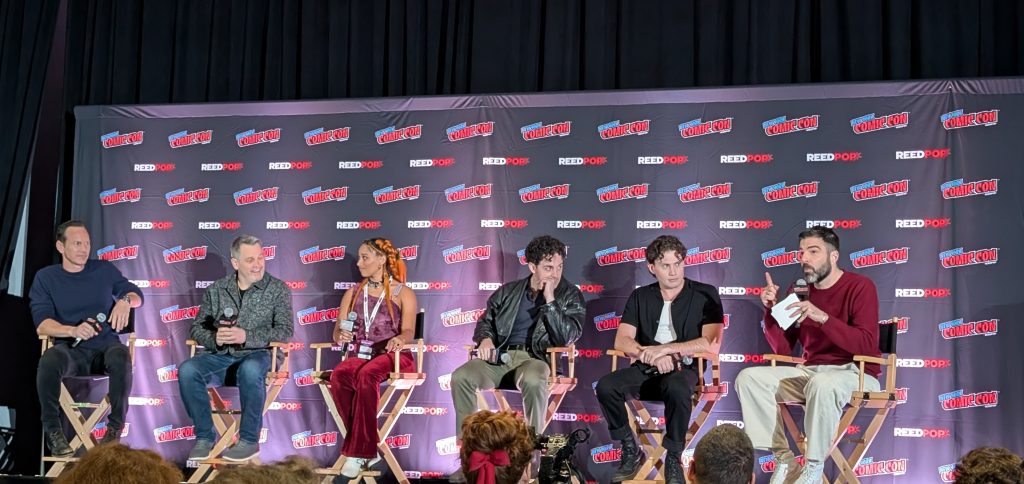
Photo taken by Samantha McLaren.
The Lost Boys: A New Musical Will Feature Flying Stunts and a Live Vampire Band
My queer heart is a sucker for musical adaptations of horror films I love, so you can be certain that I’ll be heading down to the Santa Carla Boulevard—aka Broadway’s Palace Theater—for The Lost Boys: A New Musical, which begins previews on March 27, 2026. At their NYCC panel, producer Patrick Wilson (The Conjuring franchise), director Michael Arden (Maybe Happy Ending), and cast members LJ Benet, Ali Louis Bourzgui, and Maria Wirries revealed why they feel Joel Schumacher’s 1987 classic translates so well to the stage, and what audiences can look forward to.
“There’s something that I see with both horror movies, musicals, and superhero movies—there’s an element of melodrama that’s really rewarding,” says Wilson, who began his career in musical theater and worked with Schumacher on the director’s 2004 film adaptation of The Phantom of the Opera. “Some people view it as camp, but there’s a reality of it being heightened that felt like this story cemented itself so much to being a musical.”
“They’re a biker gang, after all, and there’s a level of theatricality to that in and of itself,” says Arden. “Our biker gang also happens to play instruments.”
That’s right: the vampires will be playing instruments live on stage, which made casting twice as hard. Ali Louis Bourzgui, who plays David, the character portrayed by Kiefer Sutherland in the film, reveals that he plays guitar. And that wasn’t the only unusual request in the casting call: auditions included a flying test. (Presumably wires were involved, unless Arden has found himself a real cabal of vampires in his cast.)
Other highlights that fans can look forward to include killer music from one of Arden’s favorite bands, The Rescues. You can listen to the song “Have to Have You” right now, featuring instrumentals from Slash. The director also teases that many fan-favorite moments from the film will feature in some way in the musical, including the bridge scene and, yes, even the sexy saxophone guy.
Greg Nicotero’s Guts & Glory Marks a New Challenge for a Legend of the Business
If you like looking at gnarly practical effects in horror movies, chances are you’re familiar with Greg Nicotero’s work, whether you realize it or not. The legendary SFX artist has worked on everything from George Romero’s Day of the Dead and Sam Raimi’s Evil Dead II to Kill Bill and, more recently, The Walking Dead. The impressive extent of his resume was made clear at the panel “Shudder is Here to Scare the S*** Out of You,” in which almost any film mentioned by the other panelists was met by a small smile and a humble murmur of “worked on that” into the mic, often followed by a wild anecdote. Nicotero seems like the most interesting man in the world to grab a drink with, and his new horror competition show for Shudder—Guts & Glory—will let us see more of the man behind the makeup brush.
“Guts & Glory is one of the most fun times I’ve had on a show,” Nicotero says, teasing that the series is “part Sam Raimi, part Halloween Horror Nights, and part Survivor.”
In the six-episode first season, contestants are dropped into an Alabama swamp, where there’s an urban legend about an evil spirit. “One of the contestants gets possessed by the evil spirit, people start dying off, but in the meantime, they’re still competing and there’s a prize,” Nicotero explains.
Guts & Glory is effects-heavy, which was challenging to do in an unscripted series relying on real people’s real-time reactions. “You do a movie, you can cut and try it again,” Nicotero explains. “[This] was completely out of my wheelhouse and out of my comfort zone, but I’m really, really proud of it.”
Nicotero’s Creepshow was one of the first original shows to debut on Shudder, so he’s truly part of the DNA of the horror streamer, which celebrated its 10th anniversary this year. Guts & Glory premieres on October 14 as part of Shudder’s Season of Screams programming.
Horror Short The Littles Deserves the Big-Screen Feature Treatment
Some short films are perfectly suited to their bite-sized format, while others contain the seeds of something much bigger. At the New York Premiere of The Littles, a new short written and directed by American Horror Story producer Andrew Duplessie, I could immediately see the potential for the feature film that Duplessie hopes to make.
Equal parts charming and unsettling, The Littles stars M3GAN’s Violet McGraw as a little girl with a loose floorboard in her bedroom. One night, a scuffling sound and a crack of light between the boards lead the little girl to discover that her family isn’t alone in the house…
Duplessie says The Littles was inspired by his own experiences growing up in a creaky old house with a no-doubt overactive imagination. The short features creepy-cute stop-motion animation from Anthony Scott (The Nightmare Before Christmas), puppets by Katy Strutz (Guillermo del Toro’s Pinocchio), and some truly adorable miniature sets by Aiden Creates, all blended perfectly with the live-action scenes. Check it out if it’s playing at a festival near you, and watch this space for a (fingers-crossed) future feature!
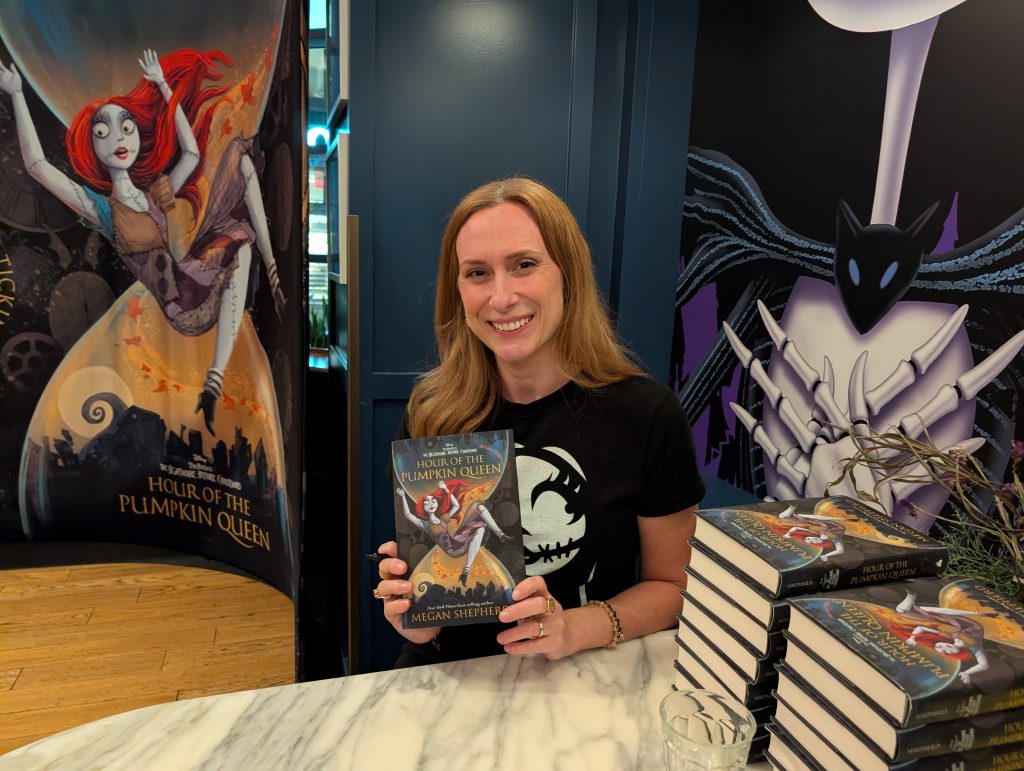
Photo taken by Samantha McLaren.
Disney Publishing’s New The Nightmare Before Christmas Tie-in Novel Welcomes Younger Fans into the Scary Fun
NYCC’s horror happenings weren’t all geared toward an adult audience. Disney Publishing took over Daily Provisions Manhattan West for a pop-up experience inspired by The Nightmare Before Christmas, featuring themed food and drinks like a delectable Pumpkin Potion coffee that I could honestly drink all season long.
At a media and creator event in the space, I took a look at the newly released Hour of the Pumpkin Queen from New York Times best-selling author Megan Shepherd, who also wrote the official novelization of The Nightmare Before Christmas for the film’s 30th anniversary in 2023. In this new tie-in novel, Sally and her rag doll apprentice, Luna, embark on a time-bending adventure to save Jack Skellington and Halloween Town after falling through a mysterious portal.
I was gifted a copy of the book by Disney, but all opinions are my own here. I’m looking forward to giving it a read during the inevitable Halloween hangover that takes place in November, before likely passing it on to my young nieces when they’re old enough. It’s a full novel, not a picture book, so definitely geared more toward a YA audience, but between the beautiful artwork on the cover and the seasonal theme, it might just be the perfect gift for the budding horror lover in your life.
That’s a wrap on New York Comic Con 2025! Be sure to bookmark Horror Press if you haven’t already so you never miss our coverage of conventions, festivals, and more.

























